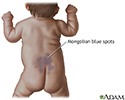Birthmarks - pigmented
Hairy nevus; Nevi; Mole; Cafe-au-lait spots; Congenital nevus
A birthmark is a skin marking that is present at birth. Birthmarks include cafe-au-lait spots, moles, and Mongolian spots. Birthmarks can be red or other colors.
Causes
Different types of birthmarks have different causes.
- Cafe-au-lait spots are common at or after birth. Someone who has many of these spots may have a genetic disorder called neurofibromatosis.
- Moles are very common -- nearly everyone has them. Most moles appear after birth.
- Mongolian spots are more common in people with darker skin.
Symptoms
Each type of birthmark has its own appearance:
- Cafe-au-lait spots are light tan, the color of coffee with milk.
- Moles are small clusters of colored skin cells.
- Mongolian spots (also called Mongolian blue spots) are usually bluish or bruised-looking. They often appear over the lower back or buttocks. They are also found on other areas, such as the trunk or arms.
Other signs of birthmarks are:
- Abnormally dark or light skin
- Growth of hair from pigmented skin
- Skin lesion (area that is different from the skin around it)
- Skin lumps
- Textured skin that can be smooth, flat, raised, or wrinkled
Exams and Tests
Your health care provider will examine your skin to make the diagnosis. You may have a biopsy to look for skin changes that are signs of cancer. Your provider may take pictures of your birthmark to compare changes over time.
Treatment
The type of treatment you have depends on the type of birthmark and related conditions. Usually, no treatment is needed for the birthmark itself.
Large birthmarks that affect your appearance and self-esteem may be covered with special cosmetics.
You may have surgery to remove moles if they affect your appearance or increase your risk for cancer. Talk to your provider about how and when any of your moles should be removed.
Outlook (Prognosis)
Large moles that are present at birth may develop melanoma, a type of skin cancer. This is especially true if the mole covers an area larger than the size of a fist. The cancer risk is related to the size, location, shape, and color of the mole.
Possible Complications
Complications of birthmarks can include:
- Skin cancer
- Emotional distress if the birthmark affects appearance
When to Contact a Medical Professional
Have your provider examine any birthmark. Tell your provider about any changes in the birthmark, such as these:
- Bleeding
- Color change
- Inflammation
- Itching
- Open sore (ulceration)
- Pain
- Size change
- Texture change
Prevention
There is no known way to prevent birthmarks. A person with birthmarks should use a strong sunscreen when outdoors.
References
Gawkrodger DJ, Ardern-Jones MR. Pigmentation. In: Gawkrodger DJ, Ardern-Jones MR, eds. Dermatology: An Illustrated Colour Text. 7th ed. Philadelphia, PA: Elsevier; 2021:chap 42.
James WD, Elston DM, Treat JR, Rosenbach MA, Neuhaus IM. Disturbances of pigmentation. In: James WD, Elston DM, Treat JR, Rosenbach MA, Neuhaus IM, eds. Andrews' Diseases of the Skin: Clinical Dermatology. 13th ed. Philadelphia, PA: Elsevier; 2020:chap 36.
Marks JG, Miller JJ. Pigmented growths. In: Marks JG, Miller JJ, eds. Lookingbill and Marks' Principles of Dermatology. 6th ed. Philadelphia, PA: Elsevier; 2019:chap 6.
Review Date: 11/18/2022
Reviewed By: Elika Hoss, MD, Assistant Professor of Dermatology, Mayo Clinic, Scottsdale, AZ. Also reviewed by David C. Dugdale, MD, Medical Director, Brenda Conaway, Editorial Director, and the A.D.A.M. Editorial team.










